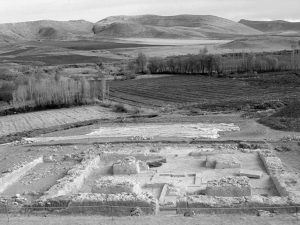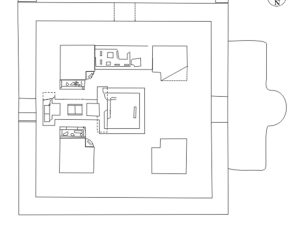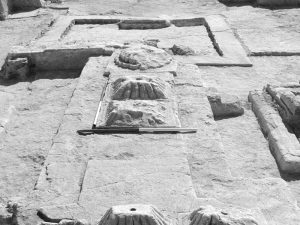Shiyānشیان
Location: Shiyān is 45 km west of Kermanshah in western Iran, Kermanshah Province.
34.08271, 6° N 46.702841° E
Location:
Historical Period:
Late Sasanian
History and Description:
The plain of Shiyān is located 45 km west of Kermanshah in the Zagros region, where there is a group of villages such as Qal’eh Shiyān and Sarāb-e Shiyān. No textual evidence exists for a fire temple at Shiyān. However, the presence of a prominent archaeological mound in the village of Qal’eh Shiyān suggests that the site was an important stop along the ancient road connecting Bisutun to Qasr-e Shirin.
The main excavated building is a square fire temple, 25 x 25 m, made of rubble masonry and gypsum plaster (fig. 1, fig. 2). The main hall, 14.5 x 14.5 m., includes the ruined bases of a chāhārtāq that once covered a central T-shaped basin marked with decorated gypsum bases. The dimension of these bases varies from 60 to 180 cm and there is a hole on top of each (fig. 3). The bases have been interpreted as fire altars or holders of flags or even seats (Khosravi, Alibaigi, Rahbar, “The Functions of Gypsum Bases in Sasanid Fire Temples,” pp. 277-278).
The archaeological site was submerged during the flooding of the Shiyān Dam in 2007.
Archaeological Exploration:
The construction of a dam on the Shiyān river between 2004 and 2007 generated rescue archaeological activities in the area, including the uncovering and subsequent conservation of a Sasanian fire temple in the flooding area behind the dam. Two seasons of rescue excavations were conducted by Hasan Rezvani on behalf of the Iranian Center for Archaeological Research in 2004 (Rezvani, Gozāresh-e kāvosh-e nejātbakhshi-ye mohavate-ye bāstāni-ye sad-e Shiyān, Kermanshah; Parvande-ye sabti-ye mohavate-ye bāstāniy-e Shiyān; Atashkade-ye Shiyān). The main period of occupation is late Sasanian, from the reign of Khosrow I onwards. The site remained occupied until the eleventh century.
Finds:
Archaeological finds consist of decorated fragments of gypsum attached to structures.
Ceramics (fig. 4): most of the ceramics are typical plain pottery of the Sasanian period.
Coins (fig. 5): Three silver coins were found in excavations, one from the time of Khosrow I, and the others from the reign of Khosrow II (dated to A.D. 597-98).
Gold earrings and pendants (fig. 6)
Glass (fig. 7): A broken glass goblet.
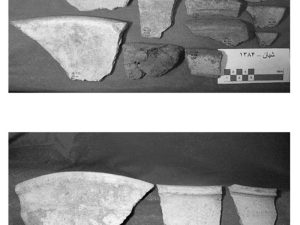
Fig. 4. Sasanian ceramics from Shiyān (photo: Hasan Rezvani)
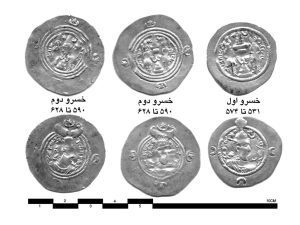
Fig. 5. Silver coins from Shiyān: left, coin of Khosrow I (r. 531-579), right, two coins of Khosrow II (r. 591-628) (photo: Hasan Rezvani)
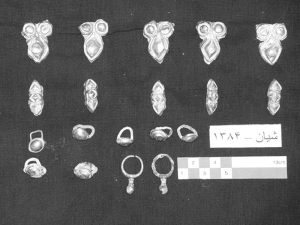
Fig. 6. Gold earrings and pendants from Shiyān (photo: Hasan Rezvani)
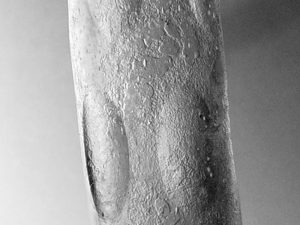
Fig. 7. Goblet in glass (photo: Hasan Rezvani)
Bibliography:
Khosravi, Sh., S. Alibaigi, and M. Rahbar, “The Functions of Gypsum Bases in Sasanid Fire Temples: A Different Proposal,” Iranica Antiqua, vol. 53, 2018, pp. 267-298.
Rezvani, H., Parvande-ye sabti-ye mohavate-ye bāstāniy-e Shiyān, unpublished report, the Iranian Center for Archaeological Research, Tehran, 1383 /2004.
Rezvani, H., Gozāresh-e kāvosh-e nejātbakhshi-ye mohavate-ye bāstāni-ye sad-e Shiyān, Kermanshah, unpublished report, the Iranian Center for Archaeological Research, Tehran, 1384/2005.
Rezvani, H., Atashkade-ye Shiyān, Kermanshah, 1385/2006.


